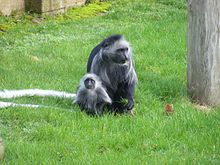King Colobus
| King colobus | |
|---|---|
 |
|
| Scientific classification | |
| Kingdom: | Animalia |
| Phylum: | Chordata |
| Class: | Mammalia |
| Order: | Primates |
| Suborder: | Haplorhini |
| Family: | Cercopithecidae |
| Genus: | Colobus |
| Species: | C. polykomos |
| Binomial name | |
|
Colobus polykomos (Zimmermann, 1780) |
|
 |
|
| King Colobus range | |
The king colobus (Colobus polykomos), also known as the western black-and-white colobus, is a species of Old World monkey, found in lowland and mountain rain forests in a region stretching from Senegal, through Guinea-Bissau, Guinea, Sierra Leone and Liberia to the Ivory Coast. It eats mainly leaves, but also fruits and flowers. Though it is arboreal, it eats primarily on the ground. It lives in small groups consisting of 3 to 4 females and 1 to 3 males, plus their young. These groups maintain distance from one another through territorial calling.
The male king colobus grows to a head-and-body length of 670 mm (26 in), with a tail of between 630 and 900 mm (25 and 35 in). The female is slightly smaller. The body is black, the limbs and fingers are long and the tail is white. There is a fringe of silvery hair around the face as well as well as long white "epaulettes" on its shoulders. The king colobus can be distinguished from other members of the Colobus genus by the placement of its white markings. The king colobus has white only on its whiskers, chest, and tail, and its tail is not covered by a tuft.
The king colobus has a moderate-sized range; it used to be a common and widespread species but numbers have declined over the last few decades. The main cause for the decline is hunting which is threatening and fragmenting populations. There is also a continuing decline in the quality and quantity of the forested habitat where it lives; it seems to be largely restricted to primary forest and gallery forest, although it sometimes visits secondary forest. The International Union for Conservation of Nature has rated its conservation status as being "vulnerable".
...
Wikipedia

